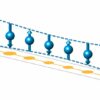It has never been easier to spread false or misleading information online. The anonymous, impersonal nature of the internet, combined with advanced tools like artificial intelligence, makes it trivial for bad actors to manipulate the truth and challenging for everyone else to separate reality from fiction. In this modern climate of disinformation, understanding how falsehoods and rumors spread is crucial for combating them.
In AIP Advances, researchers from Shandong Normal University developed a new type of rumor propagation model, taking inspiration from nuclear reactions. Their model can provide fresh insights into how online disinformation spreads and how to combat it.
Mathematical models can simulate how rumors spread and inform approaches to counter them. Commonly, they are adapted from epidemic models, where rumors stand in for microbes, as they are similarly contagious. While broadly useful, existing models fall short of capturing the complete picture of spreading misinformation.
“Infectious disease models may mostly view the spread of rumors as a passive process of receiving infection, thus ignoring the behavioral and psychological changes of people in the real world, as well as the impact of external events on the spread of rumors,” said author Wenrong Zheng.
In contrast, the team identified similarities between rumor spreading and fission, the reaction that occurs inside nuclear reactors. In their model, rumors act like neutrons, the small particles that kick off nuclear fission. These rumors are seen by individuals, who send them careening into other people in a chain reaction.
“When individuals encounter rumors, they are influenced by their personal interests and decide whether to spread or whether repeated exposure is needed before spreading,” said Zheng.
“Based on different considerations of uranium fission thresholds, individuals are divided into groups based on the influence of their own interest thresholds, fully considering individual behavior and differences, which is more in line with the reality.”
This new perspective on rumor propagation can offer insights into how rumors tend to spread, and what individuals can do to mitigate them.
“The extent of rumor propagation is closely related to the proportion of rational internet users,” said Zheng. “This reflects the importance of education: the higher the level of education, the easier it is to question rumors when receiving information that is difficult to distinguish between right and wrong.”
This approach can also help guide governments and media experts looking to counter misinformation.
“We have found that rumors propagate on a small scale at the initial stage, so official platforms need to carry out real-time monitoring. When the possibility of rumors is detected, the government or official media should check the content of the rumors and make corrections so rational citizens can effectively inhibit the propagation of rumors.”
More information:
A rumor propagation model based on nuclear fission, AIP Advances (2024). DOI: 10.1063/5.0217575
Provided by
American Institute of Physics
Citation:
A modified model designed to simulate nuclear fission sheds light on how rumors start, spread, and end (2024, July 30)



